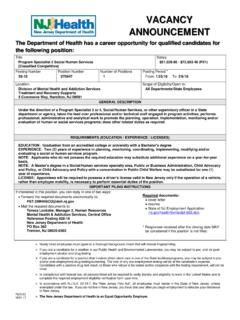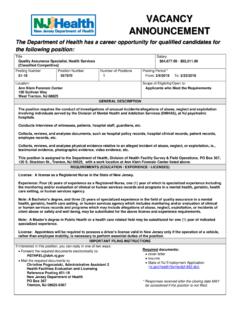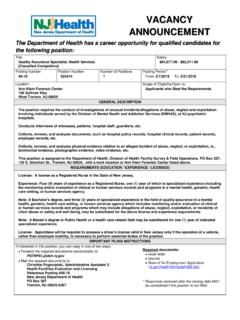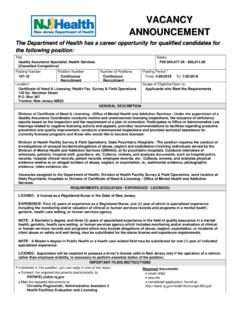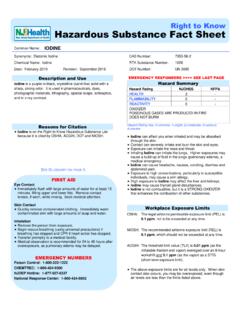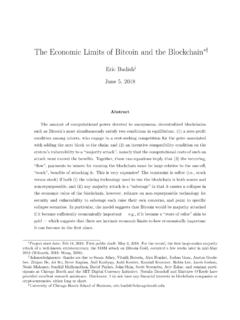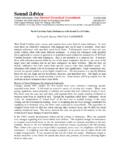Transcription of CHROMIC OXIDE HAZARD SUMMARY …
1 Common Name: CHROMIC OXIDE CAS Number: 1308-38-9 DOT Number: None DOT HAZARD Class: None ---------------------------------------- --------------------------------- HAZARD SUMMARY * CHROMIC OXIDE can affect you when breathed in. * Skin contact can cause irritation, especially if repeated or prolonged. * CHROMIC OXIDE can irritate the eyes on contact. * Skin allergy sometimes occurs with itching, redness and/or an eczema-like rash. If this happens, future contact can trigger symptoms. IDENTIFICATION CHROMIC OXIDE is a bright green, odorless powder. It is used as a paint pigment, a fixative for certain textile dyes, an abrasive, and a catalyst. REASON FOR CITATION * CHROMIC OXIDE is on the Hazardous Substance List because it is regulated by OSHA and cited by ACGIH, NIOSH, DEP, IARC, IRIS and EPA. * Definitions are provided on page 5. HOW TO DETERMINE IF YOU ARE BEING EXPOSED The New Jersey Right to Know Act requires most employers to label chemicals in the workplace and requires public employers to provide their employees with information and training concerning chemical hazards and controls.
2 The federal OSHA HAZARD Communication Standard (29 CFR ) requires private employers to provide similar training and information to their employees. * Exposure to hazardous substances should be routinely evaluated. This may include collecting personal and area air samples. You can obtain copies of sampling results from your employer. You have a legal right to this information under the OSHA Access to Employee Exposure and Medical Records Standard (29 CFR ). * If you think you are experiencing any work-related health problems, see a doctor trained to recognize occupational diseases. Take this Fact Sheet with you. RTK Substance number: 0434 Date: May 1998 Revision: December 2005 ---------------------------------------- --------------------------------- WORKPLACE EXPOSURE LIMITS The following exposure limits are for Chromium III compounds (measured as Chromium): OSHA: The legal airborne permissible exposure limit (PEL) is mg/m3 averaged over an 8-hour workshift.
3 NIOSH: The recommended airborne exposure limit is mg/m3 averaged over a 10-hour workshift. ACGIH: The recommended airborne exposure limit is mg/m3 averaged over an 8-hour workshift. WAYS OF REDUCING EXPOSURE * Where possible, enclose operations and use local exhaust ventilation at the site of chemical release. If local exhaust ventilation or enclosure is not used, respirators should be worn. * Wear protective work clothing. * Wash thoroughly immediately after exposure to CHROMIC OXIDE and at the end of the workshift. * Post HAZARD and warning information in the work area. In addition, as part of an ongoing education and training effort, communicate all information on the health and safety hazards of CHROMIC OXIDE to potentially exposed workers. CHROMIC OXIDE page 2 of 6 This Fact Sheet is a SUMMARY source of information of all potential and most severe health hazards that may result from exposure.
4 Duration of exposure, concentration of the substance and other factors will affect your susceptibility to any of the potential effects described below. ---------------------------------------- ---------------------------------- HEALTH HAZARD INFORMATION Acute Health Effects The following acute (short-term) health effects may occur immediately or shortly after exposure to CHROMIC OXIDE : * Skin contact can cause irritation, especially if repeated or prolonged. * CHROMIC OXIDE can irritate the eyes on contact. Chronic Health Effects The following chronic (long-term) health effects can occur at some time after exposure to CHROMIC OXIDE and can last for months or years: Cancer HAZARD * According to the information presently available to the New Jersey Department of Health and Senior Services, CHROMIC OXIDE has been tested and has not been shown to cause cancer in animals. Reproductive HAZARD * According to the information presently available to the New Jersey Department of Health and Senior Services, CHROMIC OXIDE has been tested and has not been shown to affect reproduction.
5 Other Long-Term Effects * Skin allergy sometimes occurs with itching, redness and/or an eczema-like rash. If this happens, future contact can trigger symptoms. MEDICAL Medical Testing If symptoms develop or overexposure is suspected, the following is recommended: * Evaluation by a qualified allergist, including careful exposure history and special testing, may help diagnose skin allergy. Any evaluation should include a careful history of past and present symptoms with an exam. Medical tests that look for damage already done are not a substitute for controlling exposure. Request copies of your medical testing. You have a legal right to this information under the OSHA Access to Employee Exposure and Medical Records Standard (29 CFR ). Conditions Made Worse By Exposure * Persons allergic to other Chromium compounds may be more likely to develop a skin allergy to CHROMIC OXIDE .
6 WORKPLACE CONTROLS AND PRACTICES Unless a less toxic chemical can be substituted for a hazardous substance, ENGINEERING CONTROLS are the most effective way of reducing exposure. The best protection is to enclose operations and/or provide local exhaust ventilation at the site of chemical release. Isolating operations can also reduce exposure. Using respirators or protective equipment is less effective than the controls mentioned above, but is sometimes necessary. In evaluating the controls present in your workplace, consider: (1) how hazardous the substance is, (2) how much of the substance is released into the workplace and (3) whether harmful skin or eye contact could occur. Special controls should be in place for highly toxic chemicals or when significant skin, eye, or breathing exposures are possible. In addition, the following control is recommended: * Where possible, automatically transfer CHROMIC OXIDE from drums or other storage containers to process containers.
7 Good WORK PRACTICES can help to reduce hazardous exposures. The following work practices are recommended: * Workers whose clothing has been contaminated by CHROMIC OXIDE should change into clean clothing promptly. * Do not take contaminated work clothes home. Family members could be exposed. * Contaminated work clothes should be laundered by individuals who have been informed of the hazards of exposure to CHROMIC OXIDE . * Eye wash fountains should be provided in the immediate work area for emergency use. * If there is the possibility of skin exposure, emergency shower facilities should be provided. * On skin contact with CHROMIC OXIDE , immediately wash or shower to remove the chemical. At the end of the workshift, wash any areas of the body that may have contacted CHROMIC OXIDE , whether or not known skin contact has occurred.
8 * Do not eat, smoke, or drink where CHROMIC OXIDE is handled, processed, or stored, since the chemical can be swallowed. Wash hands carefully before eating, drinking, applying cosmetics, smoking, or using the toilet. * Use a vacuum or a wet method to reduce dust during clean-up. DO NOT DRY SWEEP. CHROMIC OXIDE page 3 of 6 WORKPLACE CONTROLS ARE BETTER THAN PERSONAL PROTECTIVE EQUIPMENT. However, for some jobs (such as outside work, confined space entry, jobs done only once in a while, or jobs done while workplace controls are being installed), personal protective equipment may be appropriate. The OSHA Personal Protective Equipment Standard (29 CFR ) requires employers to determine the appropriate personal protective equipment for each HAZARD and to train employees on how and when to use protective equipment. The following recommendations are only guidelines and may not apply to every situation.
9 Clothing * Avoid skin contact with CHROMIC OXIDE . Wear protective gloves and clothing. Safety equipment suppliers/manufacturers can provide recommendations on the most protective glove/clothing material for your operation. * All protective clothing (suits, gloves, footwear, headgear) should be clean, available each day, and put on before work. Eye Protection * Wear eye protection with side shields or goggles. * Wear a face shield along with goggles when working with corrosive, highly irritating or toxic substances. Respiratory Protection IMPROPER USE OF RESPIRATORS IS DANGEROUS. Such equipment should only be used if the employer has a written program that takes into account workplace conditions, requirements for worker training, respirator fit testing, and medical exams, as described in the OSHA Respiratory Protection Standard (29 CFR ).
10 * NIOSH has established new testing and certification requirements for negative pressure, air purifying, particulate filter and filtering facepiece respirators. The filter classifications of dust/mist/fume, paint spray or pesticide prefilters, and filters for radon daughters, have been replaced with the N, R, and P series. Each series has three levels of filtering efficiency: 95%, 99%, and Check with your safety equipment supplier or your respirator manufacturer to determine which respirator is appropriate for your facility. * If while wearing a filter or cartridge respirator you can smell, taste, or otherwise detect CHROMIC OXIDE , or if while wearing particulate filters abnormal resistance to breathing is experienced, or eye irritation occurs while wearing a full facepiece respirator, leave the area immediately. Check to make sure the respirator-to-face seal is still good.
